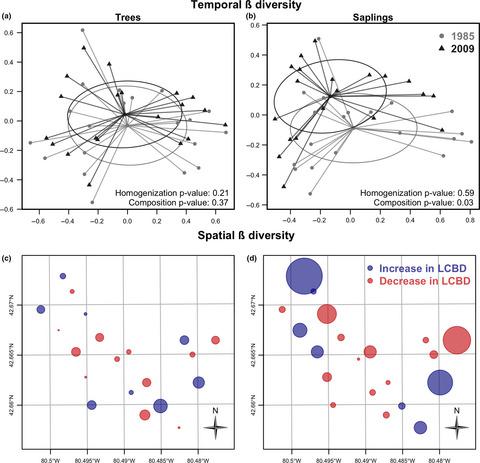当前位置:
X-MOL 学术
›
Ecol. Evol.
›
论文详情
Our official English website, www.x-mol.net, welcomes your feedback! (Note: you will need to create a separate account there.)
Changes in beta diversity and species functional traits differ between saplings and mature trees in an old‐growth forest
Ecology and Evolution ( IF 2.6 ) Pub Date : 2020-12-18 , DOI: 10.1002/ece3.6913 David Anthony Kirk 1 , Marie‐Hélène Brice 2, 3 , Michael S. Bradstreet 4 , Ken A. Elliott 5
Ecology and Evolution ( IF 2.6 ) Pub Date : 2020-12-18 , DOI: 10.1002/ece3.6913 David Anthony Kirk 1 , Marie‐Hélène Brice 2, 3 , Michael S. Bradstreet 4 , Ken A. Elliott 5
Affiliation

|
Invasion by generalist tree species can cause biotic homogenization, and such community impoverishment is likely more important in rare forest types. We quantified changes in tree diversity within Carolinian (range in Central Hardwood Forest), central (range in Central Hardwood Forest and Northern Hardwood‐Conifer Forest), and northern species [range reached Northern‐Conifer‐Hardwood/closed Boreal (spruce‐Fir) Forest] in an old forest tract in southern Canada at points surveyed 24 years apart. We asked: How did mature tree and sapling composition and abundance change for the three species’ groups? Did those changes lead to biotic homogenization? Can species’ changes be explained by community traits? We tested for differences in temporal and spatial tree β‐diversity, as well as forest composition and structure, using univariate/multivariate analyses and a community trait‐based approach to identify drivers of change. Major increases occurred in abundance for mature Acer rubrum (northern), while other species decreased (Fraxinus americana, Populus grandidentata); declines were found in A. saccharinum (central) and Cornus florida (Carolinian). Species composition of saplings, but not mature trees, changed due to replacement; no evidence for biotic homogenization existed in either cohort. As a group, northern mature tree species increased significantly, while central species decreased; saplings of pooled Carolinian species also declined. Shade tolerance in mature trees increased, reflecting successional changes, while drought tolerance decreased, perhaps due to changing temperatures, altered precipitation or ground water levels. Saplings showed declines in all traits, probably because of compositional change. Our results demonstrated that saplings can more closely reflect change in forest dynamics than mature trees, especially over short time periods. Based on sapling trends, this remnant could ultimately transition to a mesophytic hardwood stand dominated by A. rubrum and other shade‐tolerant species, creating a more homogeneous forest. While encouraging regeneration for Carolinian and central tree species could ensure high levels of diversity are conserved in the future, it is important to balance this with the primary management goal of maintaining the forest's old‐growth characteristics.
中文翻译:

幼龄森林中的幼树和成熟树木的β多样性和物种功能性状的变化有所不同
通才树种的入侵可能导致生物同质化,而这种社区贫困在稀有森林类型中可能更为重要。我们量化了卡罗莱纳州(中央硬木森林中的范围),中央(中央硬木森林和北部硬木-针叶树森林的范围)和北部物种(范围达到北针叶树-硬木/封闭的北方(云杉-冷杉)范围内的树木多样性变化森林]位于加拿大南部一个古老的森林地区,相距24年。我们问:这三个树种的成熟树和幼树的组成以及丰度如何变化?这些变化是否导致生物均质化?物种的变化可以用群落特征来解释吗?我们测试了时空树β多样性以及森林组成和结构的差异,使用单变量/多变量分析和基于社区特征的方法来确定变化的驱动力。大量增加的成熟度红枫(北宏),而其他物种减少(美洲白蜡树,大杨)。糖曲霉(中央)和山茱Corn的数量下降(加泰罗尼亚语)。幼树的树种组成,但未成熟的树种由于更换而发生了变化;在这两个队列中均没有生物均质的证据。总体而言,北部成熟树种显着增加,而中央树种则减少。合并的卡罗莱纳树种的树苗也下降了。成熟树木的耐荫性增强,反映了连续的变化,而耐旱性下降了,这可能是由于温度变化,降水变化或地下水位引起的。幼树的所有性状均下降,这可能是由于成分变化所致。我们的结果表明,幼树比成熟树木更能反映森林动态的变化,尤其是在短时间内。根据幼树的趋势,该残留物可能最终过渡到以A. rubrum和其他耐荫物种,创造出更加均匀的森林。虽然鼓励卡罗莱纳州和中心树种的再生可以确保将来保护高水平的多样性,但重要的是要与保持森林老龄化特征的主要管理目标相平衡。
更新日期:2021-01-08
中文翻译:

幼龄森林中的幼树和成熟树木的β多样性和物种功能性状的变化有所不同
通才树种的入侵可能导致生物同质化,而这种社区贫困在稀有森林类型中可能更为重要。我们量化了卡罗莱纳州(中央硬木森林中的范围),中央(中央硬木森林和北部硬木-针叶树森林的范围)和北部物种(范围达到北针叶树-硬木/封闭的北方(云杉-冷杉)范围内的树木多样性变化森林]位于加拿大南部一个古老的森林地区,相距24年。我们问:这三个树种的成熟树和幼树的组成以及丰度如何变化?这些变化是否导致生物均质化?物种的变化可以用群落特征来解释吗?我们测试了时空树β多样性以及森林组成和结构的差异,使用单变量/多变量分析和基于社区特征的方法来确定变化的驱动力。大量增加的成熟度红枫(北宏),而其他物种减少(美洲白蜡树,大杨)。糖曲霉(中央)和山茱Corn的数量下降(加泰罗尼亚语)。幼树的树种组成,但未成熟的树种由于更换而发生了变化;在这两个队列中均没有生物均质的证据。总体而言,北部成熟树种显着增加,而中央树种则减少。合并的卡罗莱纳树种的树苗也下降了。成熟树木的耐荫性增强,反映了连续的变化,而耐旱性下降了,这可能是由于温度变化,降水变化或地下水位引起的。幼树的所有性状均下降,这可能是由于成分变化所致。我们的结果表明,幼树比成熟树木更能反映森林动态的变化,尤其是在短时间内。根据幼树的趋势,该残留物可能最终过渡到以A. rubrum和其他耐荫物种,创造出更加均匀的森林。虽然鼓励卡罗莱纳州和中心树种的再生可以确保将来保护高水平的多样性,但重要的是要与保持森林老龄化特征的主要管理目标相平衡。


























 京公网安备 11010802027423号
京公网安备 11010802027423号